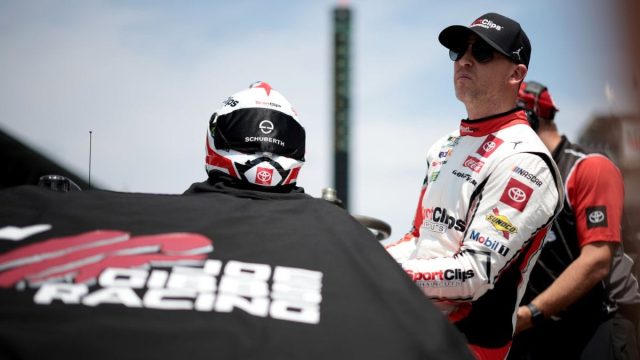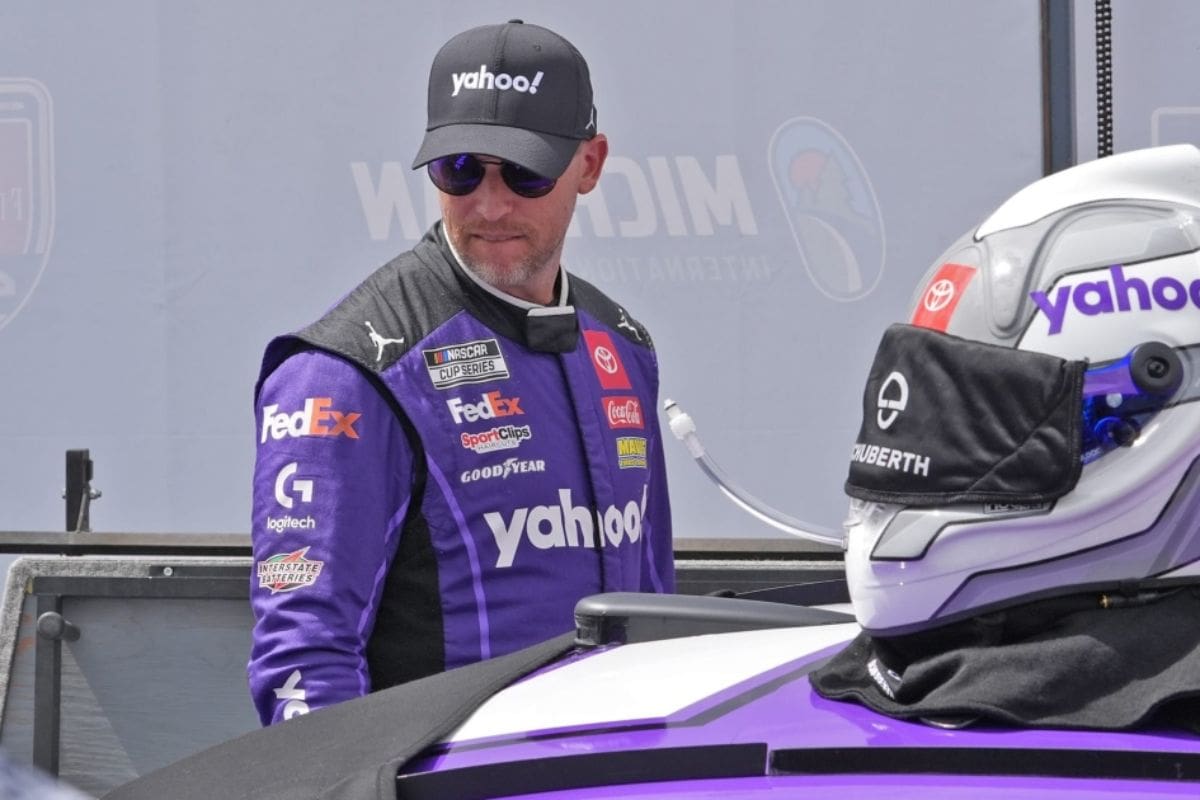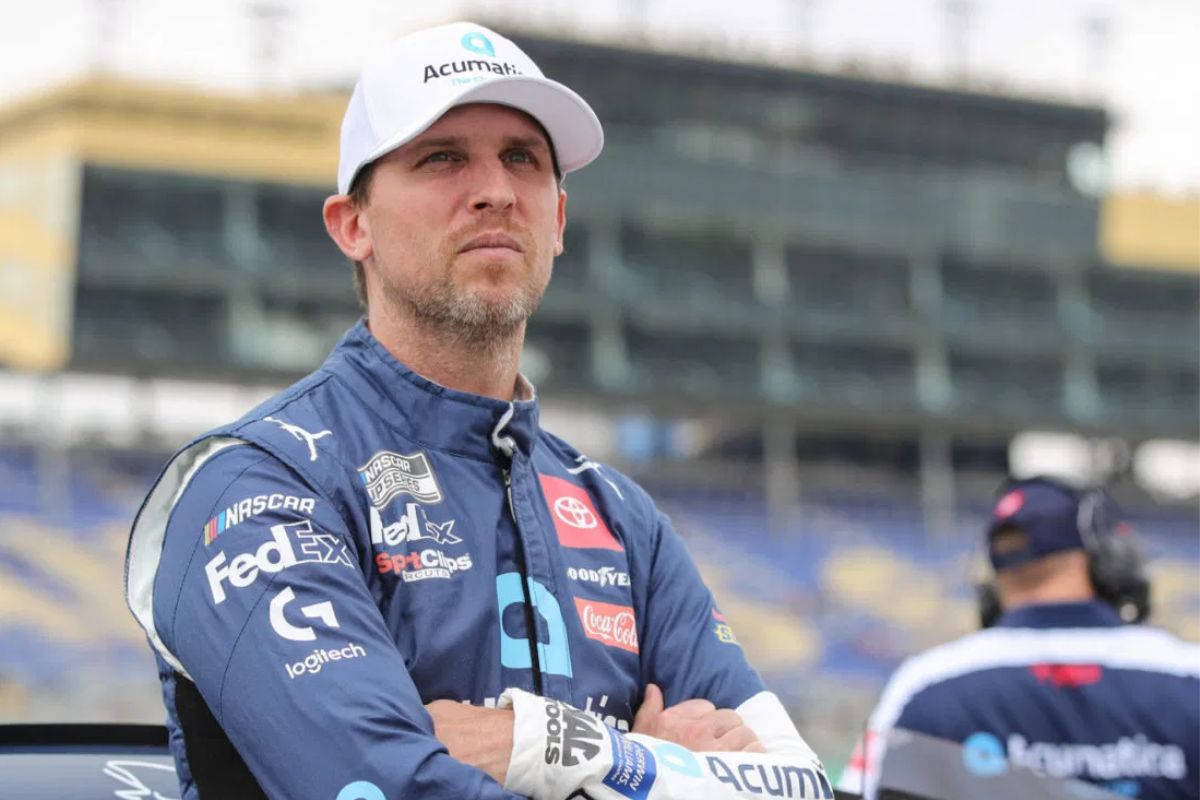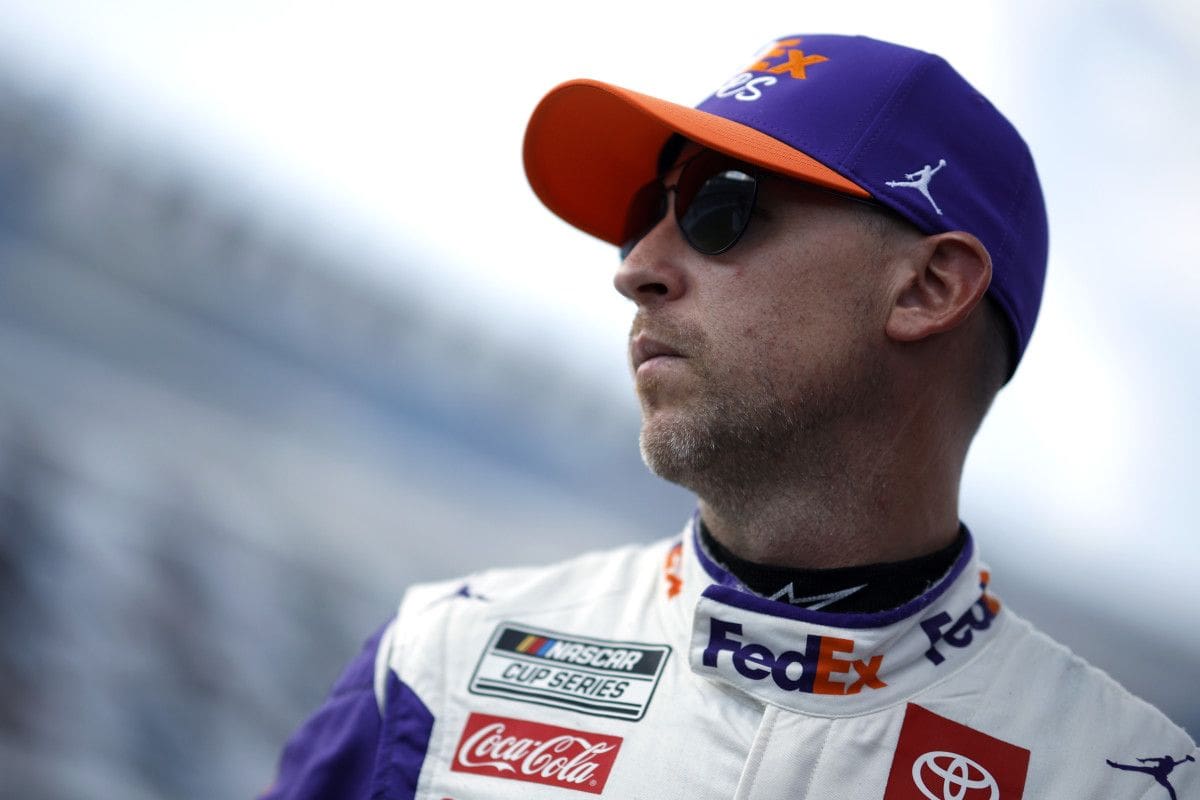Denny Hamlins Post-Race Guilt: Denny Hamlin‘s frank admission of guilt following his 16th-place finish at Michigan serves as a reminder of the significant stakes and emotional toll inherent in NASCAR racing. His reflection, marked by the phrase “It was really bad,” not only reveals personal accountability but also highlights the strain drivers face to perform. Furthermore, the dynamics of his relationship with crew chief Chris Gabehart become essential in navigating the aftermath of such disappointments.
Key Highlights
- Denny Hamlin expressed deep guilt following his 16th-place finish at Michigan, highlighting the emotional burden of competitive racing.
- The Michigan race featured significant damage to Hamlin’s vehicle, contributing to feelings of accountability and frustration.
- Hamlin’s aggressive driving style often leads to high-stakes outcomes, balancing between thrilling wins and dramatic failures.
- His relationship with crew chief Chris Gabehart is crucial for maintaining a positive outlook post-race despite setbacks.
- The emotional weight of racing events emphasizes the human side of competition, impacting drivers’ mental states and performance.
Denny Hamlin’s All-or-Nothing Approach
In NASCAR, Denny Hamlin embodies an all-or-nothing approach that both captivates fans and raises eyebrows among analysts. His mantra, “We either crash or we win,” perfectly encapsulates a driving philosophy that prioritizes aggressive tactics over measured conservatism. This philosophy has marked his career, resulting in thrilling victories interspersed with dramatic wrecks, creating a polarizing narrative that keeps fans on the edge of their seats.
During the 2023 season, Hamlin’s performance oscillated between the exhilarating and the calamitous. His success at Dover demonstrated his ability to seize the moment, yet his frequent entanglements at the rear of the field exemplify a precarious balance between risk and reward.
The Michigan race serves as a example of this dichotomy; while Hamlin managed a respectable finish, it was a rarity in a season defined by either soaring successes or disastrous falls from grace.
This relentless pursuit of victory fosters a unique dynamic within NASCAR, where Hamlin’s reputation is forged as much by his bold actions as by the inevitable missteps that accompany them. Analysts often debate the sustainability of this strategy, particularly as the sport evolves and competition intensifies.
Yet, it is precisely this approach that has cemented Hamlin’s status as both a strong competitor and a compelling figure within the NASCAR, leaving fans and experts similarly to ponder whether the potential rewards justify the inherent risks.
Impact of Weather on Michigan Race
Amidst the swirling clouds and unpredictable conditions, the weather played a vital role in shaping the outcome of the Michigan race. The inclement weather appreciably hampered drivers’ pace at the two-mile oval, leading to a unique set of challenges that tested both skill and strategy.
With practice sessions curtailed, teams were forced to rely on metrics rather than firsthand experience on the track, creating an environment ripe for uncertainty. This reliance on data rather than practical testing meant that drivers like Denny Hamlin faced considerable disadvantages.
The lack of adequate practice time disrupted the teams’ ability to fine-tune their setups, leaving them ill-prepared for the race conditions that awaited them. Consequently, the performance of vehicles was not fully optimized, leading to slower lap times and an increased potential for errors.
Moreover, the absence of qualifying sessions further compounded the intricacies of the race. Starting positions were determined by metrics, which may not accurately reflect the true competitive dynamics on race day. As drivers navigated the challenges posed by the weather, the racing landscape became a test of adaptability and resilience.
Bad Luck Clouds Over Denny Hamlin
Denny Hamlin has found himself once again caught in the crosshairs of bad luck, a recurring theme that has shadowed his recent performances. The Michigan International Speedway presented yet another challenge, as Hamlin struggled to regain momentum after an unfortunate spin while chasing fellow driver Bubba Wallace.
This incident marked the alternate consecutive race where Hamlin faced a precarious situation, evocative of his earlier encounter at Richmond, where a right-hook from Austin Dillon sent him crashing into the wall. Such misfortunes have impacted his race outcomes and left him grappling with a sense of frustration and disappointment.
The following points highlight the gravity of Hamlin’s current predicament:
- Consecutive Incidents: Two races in a row blemished by potential wrecks highlight a troubling pattern.
- Aero-Blocking Vulnerability: The Michigan track’s aero-blocking tendency proved detrimental, affecting Hamlin’s ability to maintain control.
- Damage Control: After spinning out, Hamlin was left to navigate the remainder of the race with compromised performance.
As Hamlin reflects on these challenges, it becomes clear that bad luck is not merely a random occurrence but a crucial factor influencing his path this season.
Hamlin’s Reflections on His Finish
Following his streak of unfortunate events, Hamlin’s reflections on his recent finishes reveal the depth of his frustration and sense of responsibility. His 16th-place finish in the Sunday segment was a glaring contrast to his subsequent 9th-place result on Monday, a confirmation of the inherent unpredictability of racing. However, these results did not alleviate the weight of his post-race guilt.
Hamlin openly acknowledged the damage sustained during the race, stating, “It was bad, it was really, really bad. It was tore up.” This admission emphasizes the significant nature of his role within the team dynamics, where performance is not solely measured by individual achievement but also by the collective success of the crew.
“It was bad, it was really, really bad. It was tore up…I mean, he (Chris Gabehart) sent me some pictures overnight that just did not look good…It’s unfortunate man, I hate that I did that to the team and certainly set us back.” – denny
Hamlin’s sentiments reflect an athlete’s burden of accountability; he expressed regret for how his actions might have set the team back. His relationship with crew chief Chris Gabehart is critical, as evidenced by Hamlin’s reliance on Gabehart’s guidance to maintain an optimistic outlook amidst adversity.
“I still was optimistic ’cause you know…Chris is gonna make sure he doesn’t give me total Denny Downer information before the race starts.” – denny
The images shared by Gabehart served as a glaring reminder of the repercussions of racing misfortunes, yet they also highlighted the resilience required to navigate such challenges.
“But he says, listen, we’re not gonna get it back where it was, even if we can get it like, somewhat close. After we started there, obviously we were not close. We then had to make adjustments to the car itself, handling-wise, to pick up the second that we did in the second half of that race.” – Denny
While Hamlin grapples with his feelings of guilt, his hopefulness remains an essential element of his mindset. The ability to remain optimistic in the face of setbacks is often what distinguishes successful competitors from their peers.
Reddick’s Dedication to Scott Bloomquist
In the wake of a profound loss, Tyler Reddick found a opportunity to honor the memory of Scott Bloomquist, a revered figure in the world of Dirt Late Model racing. The tragic passing of Bloomquist in a plane crash on August 16th left a considerable void in the motorsports community, affecting many, including Reddick, who had a longstanding friendship with the late racer.
Following his impressive victory over William Byron, Reddick dedicated his win to Bloomquist, expressing both gratitude and sorrow in a heartfelt statement. Reddick’s dedication served as a tribute to their bond and emphasized the impact Bloomquist had on those around him.
In Victory Lane, he articulated his sentiments, stating, “The last couple days have been tough, but this really helps. This win goes to him and his family and friends.” His words resonated deeply, reflecting not only personal loss but also the communal grief shared by the racing community.
“The last couple days have been tough, but this really helps. This win goes to him [Bloomquist] and his family and friends, and all that meant a lot to him. It’s always tough when someone you care about passes away. We did a really good job today.”
“I think we were the last car on the lead lap starting stage three today so good effort for us.” – Reddick
- Legacy: Bloomquist’s contributions to racing transcended mere accolades, influencing generations of drivers.
- Community: The fellowship among racers is palpable, often transforming friendships into familial bonds.
- Resilience: Reddick’s victory amidst grief demonstrates the strength of the human spirit in overcoming adversity.
- Tribute: Dedicating wins to fallen legends honors their legacy, ensuring their memory lives on.
News in Brief: Denny Hamlins Post-Race Guilt
Denny Hamlin’s post-race reflections shows the profound emotional toll experienced by NASCAR drivers. The intense strain to perform, coupled with the weight of responsibility for mistakes, demonstrates the significant risks inherent in the sport. Hamlin’s frank acknowledgment of guilt following a challenging Michigan finish highlights the critical role of support systems, particularly his relationship with crew chief Chris Gabehart. This dynamic fosters resilience and perspective, vital traits for steering through the unpredictable nature of competitive racing.
ALSO READ: Denny Hamlin’s Michigan Mishap: The Spin That Shook the FireKeepers 400



